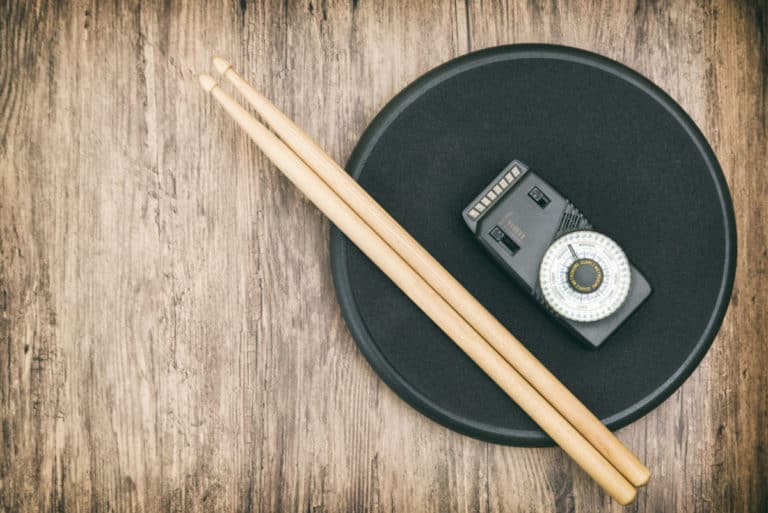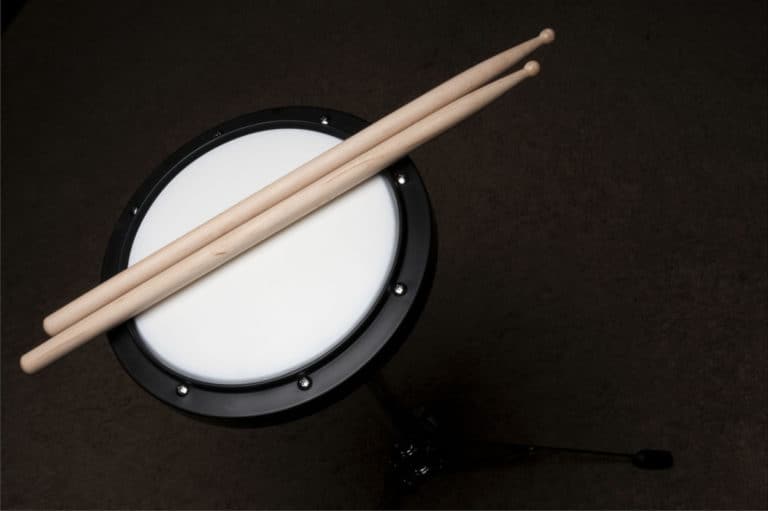How Hard Is It To Learn Drums?
Drums are a rewarding and challenging instrument that forms a unique element among many bands today. Playing the drums requires coordination of the entire body and an acute understanding of rhythm, while drum equipment is also a complex piece of the puzzle that must be understood in order for the player to reach their true potential. If you’re interested in learning drums, it’s important to start off on the right foot.
Learning the drums can be hard, but that doesn’t always mean it will be. There are several factors that go into determining how hard learning the drums will be for you, including innate ability, your level of dedication, and the availability of free time you have for practicing.
In this article, you’ll find detailed information on how difficult it is and how long it takes to learn drums, as well as a comparison between the learning curve for drums and guitar.
Is It Hard to Learn Drums?
It can be hard, expensive, and time-consuming to learn to play drums. They are more physical than instruments such as guitar or saxophone. Furthermore, the movements and techniques associated with drumming require an entirely different finesse compared to what’s needed for other instruments.
How Long Will It Take To Learn Drums?
The time it takes to learn drums will vary according to your goals and the way you practice. However, there are a few milestones that can be ballparked fairly easily.
It takes two or more years of regular practice to learn drums to a point where you can play on stage with a band. However, you can start having fun and learning songs much earlier.
It should only take you a few weeks to get a handle on the basic techniques behind drumming. Once you feel comfortable behind a kit, then you can start progressing with more advanced knowledge.
There are a few important techniques and practices that every drummer should know. In particular, there are groups of rhythmic patterns known as rudiments. There are many different rudimentary structures for drum techniques, but the most common one today is the Percussive Arts Society International Drum Rudiments.
Learning these rudimentary rhythms and patterns will give you a very strong base to build on for your drumming ability. We’ll talk more about drum rudiments later on in this article. For now, let’s focus on some of the basic techniques involved in drumming.
Basic Techniques
First of all, one of the most important things to remember is ear protection. Drums are typically extremely loud, and you’ll quickly deafen yourself if you insist on playing without any hearing protection.
Earplugs are effective, but a good set of drummer’s headphones such as the Vic Firth Isolation Headphones (available on Amazon.com), can reduce the noise by 25 decibels. This product is a much better solution; allowing the drummer to plug into the sound system in order to hear other instruments or run click tracks.
A drum kit is typically played in a sitting position, with the drummer using a drumstick in each hand to strike drum heads while using their feet to operate pedals. The left foot usually controls the hi-hat cymbal, while the right foot controls the bass drum pedal. However, alternative setups are becoming more common.
One of the most important things to focus on in the beginning is limb independence. People who’ve never practiced drums before often find it difficult at first to move their limbs independently from each other. For example, some people have difficulty using their hands and feet for different patterns simultaneously.
In order to train your limbs to move independently from one another, you should start by practicing a basic beat, and moving on to more complex rhythms once you’re comfortable. Build a repertoire of different beats and fills and practice alternating between them.
Another important technique for basic drumming is the grip. There are a few different ways that a drummer can grip their sticks, and each is suited to a different genre. The ‘matched grip’ is the one most commonly used by drummers in rock or pop bands, while the ‘classic grip’ is used widely in classical music. However, some drummers, such as Neil Peart, have found success with using different grips in different situations.
Counting
The most important skill a drummer can possibly learn is how to count rhythms. Since the drummer is the rhythmic backbone of the band, being able to keep a beat is essential. You can’t be a professional drummer who doesn’t know how to count. You’ll end up losing your place and becoming unable to keep the rest of the band on time.
If you’re just starting out, then most of the rhythms you play will be in common time (also known as 4/4). This is a really simple time signature that typifies almost every single song you’ll hear on the radio these days. However, there are also other common rhythms (such as 3/4 or 6/8) as well as advanced rhythms for genres such as jazz and progressive rock.
The key to counting rhythms effectively is to train your body to recognize intervals of time. For this reason, it’s important to practice along to a metronome or even one of your favorite songs. Count the rhythms and practice counting while playing. Eventually, you’ll be able to count in your head without thinking about it too hard.
Rudiments
Rudiments, as mentioned earlier, are a system of rhythms and techniques that start out simple and become more difficult as you progress through the series. The PAS International Drum Rudiments are the most commonly taught today, and they start with a basic drum roll.
There are a few other systems, such as French rudiments, that may be more useful if you plan on doing something like marching drums, which rely much more heavily on rudimentary patterns than other styles of drumming. No matter what genre you intend to play, practicing complex rudimentary patterns will always help you become a better drummer.
Since rudiments are typically written with musical notation, it might be a good idea to read up a bit on how to read sheet music for drums. Don’t be scared; drum notation is significantly more intuitive than musical notation for other instruments, especially if you’re only playing a small kit. If you know how to read sheet music, you’ll be much more welcome in an organized band setting where being able to do so is an absolute requirement.
You don’t have to focus solely on rudiments as you continue to practice. You can still play around with basic beats and even begin trying to play along to your favorite music. The rudiments simply give you a backbone of important techniques and rhythms that you can use to supplement your skills with the instrument.
In fact, it’s a good idea to always include rudimental practice when you’re playing drums. Even if you’ve been playing for ten years, rudiments are an excellent way to warm up your limbs and get them ready for more complicated patterns. Even the pros have to keep practicing the basics from time to time.
Advanced Techniques
Once you play the drums for a few months, you’ll get an idea of what you like to play, as well as areas where you can improve. If you listen to music with complicated drum beats, you probably know some techniques already that you want to start practicing.
The drums are a complex instrument, requiring much more rhythmical awareness and proprioception than other instruments like guitar or saxophone. Techniques such as blast beats, polymeters, and rhythmic displacement can be extremely rewarding to learn, and adding to your repertoire of techniques will continuously make you a better drummer as time goes on.
If you don’t know what to do next, then just pick a song you like and try to play it! Many famous drummers, such as Buddy Rich, were completely self-taught. The key to learning any instrument is persistence.
If you eventually hit a plateau with your learning and you don’t know what to do, then it can be a good idea to shell out for drum lessons. In addition to teaching you how to play, many drum teachers will also help students find decent used drum sets on which to start practicing.
Are Drums Harder Than Guitar?
Some people consider drums to be one of the more difficult instruments to learn. The reason for this is the physical requirements of the instrument, as well as the lack of overlap with other instruments. While learning drums is demanding, it’s by no means impossible.
Drums can be harder than guitar for some people due to the physical requirements. However, others may find drums easier to learn due to the relative simplicity of the techniques compared to guitar.
Guitar requires a great deal of memorization in order to play competently. You can’t just learn a few basic rhythms to jam out on guitar; you need to practice complex scales and modes before you can hope to have a fluent understanding of the instrument. A good drum student can learn to play popular songs in just a couple lessons.
Posture
The way you sit is one of the most important factors in drumming. You need to be comfortable sitting up straight in a position that allows you to hit all of the drums in your kit. If you have to crane your body to hit different drums, then you might be making things more difficult for yourself.
It’s also possible to sustain injury if you play the drums with bad posture or with an incorrect grip on your sticks. This is especially true if you frequently play for long periods of time. Carpal tunnel is serious business, so practicing good posture is essential. Many drummers who play for years also end up with knee problems or back issues due to practicing bad posture throughout their careers.
Posture for guitar is mainly focused on how to hold the instrument so that your fingers can easily be used to press down on the frets and pluck the strings. While posture is still important for guitar, it is much more important for drums since you’ll be moving your body a lot more than a guitar player.
Limb Independence
A guitarist must learn to move their fingers independently, as well as how to strum with one hand while fingering frets with the other. A drummer must learn how to move all four of their major limbs independently from one another in order to truly master the instrument.
For this reason, drummers (especially beginners) must devote a lot of time to practicing their limb independence. Even as you get better, you should make sure that you’re practicing various rhythms and techniques to get your limbs used to moving out-of-sync.
Limb independence is especially important for genres that incorporate complex time changes, such as jazz or progressive rock. However, no matter what genre you intend to play, learning to move your limbs independently is one of the most important differences between drums and guitar.
Muscle Memory
Eventually, as you practice different rhythms and techniques, your body will start to get used to the various movements. You’ll find that your body will automatically start to react with certain patterns, making various techniques easier as you practice.
This is both a blessing and a curse since overdeveloped muscle memory will pigeonhole your body into certain patterns. This is one of the main reasons that rudimental drumming is so important; it teaches your body to memorize basic patterns, which can then be used as part of a versatile whole.
Muscle memory training for drums is arguably easier than for guitar since guitarists must memorize hundreds of different patterns in order to play effectively. A drummer can function competently with only a couple dozen rhythms, especially in simpler genres like classic rock or pop.
Equipment Cost and Maintenance
Although guitar equipment can be very expensive, so too can a decent drum kit. When you’re just starting out learning an instrument, it’s recommended to go with a cheaper alternative with a basic set of features rather than a super-expensive piece of equipment. The reason for this is that the more expensive equipment is basically overkill for a beginner; they can learn the basics just fine without all the added “bells and whistles.”
For a guitar, the basic set up you will need is the guitar itself and an amplifier if you plan on playing electric. Professional guitarists use half-stack or full-stack amplifier setups that incorporate effects loops and other goodies, but beginners typically go with what is called a combination amplifier. This allows them to amplify their guitar with some simple effects, and is all you need to start learning to play the electric guitar.
A drum kit is a bit more complex than that. Even beginner kits contain many pieces, and it can be hard to select a kit that is durable, affordable, and fun to play. The first thing you will want to worry about is the number of pieces in the kit. A basic kit will have a snare drum, bass drum and pedal, and a hi-hat. Most beginner kits also incorporate toms and crash or ride cymbals.
A full drum kit, even one for beginners, will have a similar cost to an electric guitar and combo amp. It will be in the range of a few hundred dollars. However, parts of a drum kit will need to be frequently replaced, such as the skins, sticks, and sometimes the cymbals. This problem can be mitigated by getting decent-quality hardware, but it is still something that happens from time to time.
Tuning a drum kit is also more time consuming and difficult than tuning a guitar. You need a specialized drum key to tune the skins, and most of the kit must be disassembled in order to properly tune them. If you need more information on how to tune a drum kit, you can check out this page.
The plus side of this is that new drums, cymbals, and other accessories can easily be added to an existing kit. Used kits and beginners kits can also be made to sound pretty good with some decent tuning, whereas a cheap guitar amplifier will always sound cheap no matter what. Some recording artists, such as Zack Hill of Hella, are famous for playing heavily used drum kits.
Final Thoughts
Playing the drums can be a very challenging endeavor. However, it can also be rewarding. If you’re the type of person who likes to follow intricate patterns while exercising their entire body, then you’ll find drumming to be a relaxing and fulfilling experience.
Instruments like guitar or piano require a lot of memorization of scales and modes, which can make them more difficult to learn for some people. Drumming is about using your whole body effectively while keeping a beat for the rest of the band.
If you have any questions, feel free to ask in the comments section.







